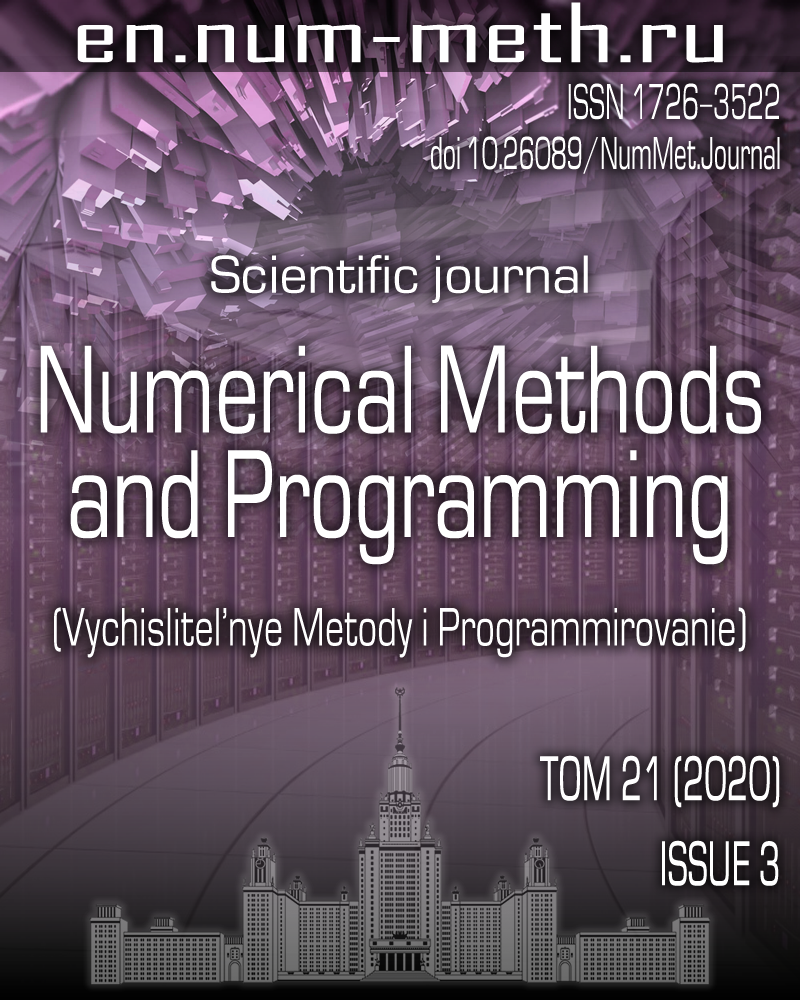DOI: https://doi.org/10.26089/NumMet.v21r327
Digital image reduction for analysis of topological changes in the pore space of the rock matrix during chemical dissolution
Keywords:
persistence homology
digital image reduction
chemical dissolution
Abstract
A new algorithm for the reduction of three-dimensional digital images is proposed to improve the performance of persistence diagrams computing. These diagrams represent changes in topology of the pore space in the rock matrix. The algorithm has a linear complexity, since the removal of the voxel is based on the structure of its neighborhood. It is shown that the efficiency of the algorithm depends heavily on the complexity of the pore space and the size of filtering steps.
Published
2020-09-27
Issue
Section
Methods and algorithms of computational mathematics and their applications
References
- M. Ghommem, W. Zhao, S. Dyer, et al., “Carbonate Acidizing: Modeling, Analysis, and Characterization of Wormhole Formation and Propagation,” J. Petrol. Sci. Eng. 131, 18-33 (2015).
- H. O. McLeod, “Matrix Acidizing,” J. Petroleum Technol. 36 (12), 2055-2069 (1984).
- F. Huang, P. Bergmann, C. Juhlin, et al., “The First Post-Injection Seismic Monitor Survey at the Ketzin Pilot CO_2 Storage Site: Results from Time-Lapse Analysis,” Geophys. Prospect. 66 (1), 62-84 (2018).
- T. Vanorio, G. Mavko, S. Vialle, and K. Spratt, “The Rock Physics Basis for 4D Seismic Monitoring of CO_2 Fate: Are We There Yet?,” Lead. Edge 29 (2), 113-240 (2010).
- M.-J. Cui, J.-J. Zheng, R.-J. Zhang, et al., “Influence of Cementation Level on the Strength Behaviour of Bio-Cemented Sand,” Acta Geotech. 12 (5), 971-986 (2017).
- H. Edelsbrunner and J. L. Harer, Computational Topology: An Introduction (AMS Press, Providence, 2010).
- K. A. Gadylshina, T. S. Khachkova, and V. V. Lisitsa, “Numerical Modeling of Chemical Interaction between a Fluid and Rocks,” Vychisl. Metody Programm. 20, 457-470 (2019).
- R. V. Vasilyev, K. M. Gerke, M. V. Karsanina, and D. V. Korost, “Solution of the Stokes Equation in Three-Dimensional Geometry by the Finite-Difference Method,” Mat. Model. 27 (6), 67-80 (2015) [Math. Models Comput. Simul. 8 (1), 63-72 (2016)].
- Ya. V. Bazaikin, Lectures on Computational Topology (Novosibirsk Gos. Univ., Novosibirsk, 2017) [in Russian].
- H. Wagner, C. Chen, and E. Vuçini, “Efficient Computation of Persistent Homology for Cubical Data,” in Topological Methods in Data Analysis and Visualization II. Mathematics and Visualization (Springer, Heidelberg, 2012), pp. 91-106.
- M. Mrozek and B. Batko, “Coreduction Homology Algorithm,” Discrete Comput. Geom. 41 (1), 96-118 (2009).
- M. Mrozek and T. Wanner, “Coreduction Homology Algorithm for Inclusions and Persistent Homology,” Comput. Math. Appl. 60 (10), 2812-2833 (2010).
- J. D. Hyman and C. L. Winter, “Stochastic Generation of Explicit Pore Structures by Thresholding Gaussian Random Fields,” J. Comput. Phys. 277, 16-31 (2014).
- Y. Al-Khulaifi, Q. Lin, M. J. Blunt, and B. Bijeljic, “Pore-Scale Dissolution by CO_2 Saturated Brine in a Multi-Mineral Carbonate at Reservoir Conditions: Impact of Physical and Chemical Heterogeneity,” (2019)
doi 10.5285/52b08e7f-9fba-40a1-b0b5-dda9a3c83be2 . Cited August 18, 2020
License
Copyright (c) 2020 Numerical methods and programming

This work is licensed under a Creative Commons Attribution 4.0 International License.


